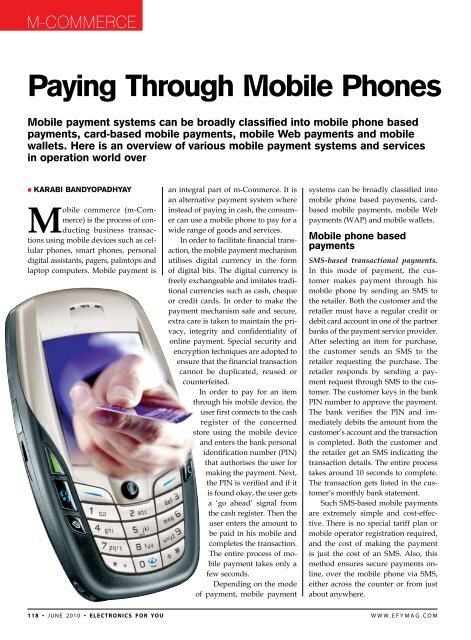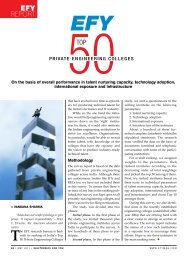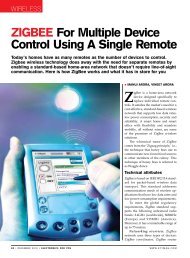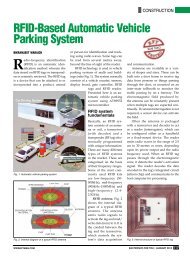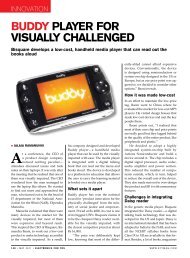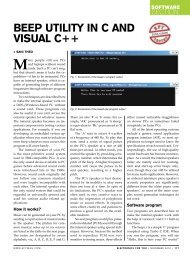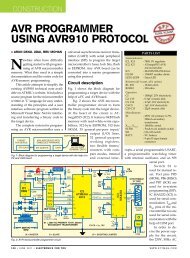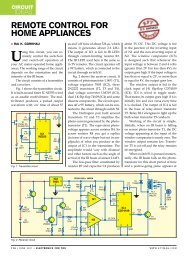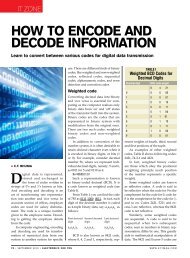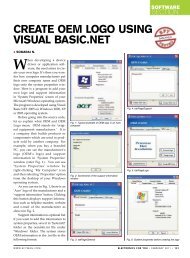Paying Through Mobile Phones
Paying Through Mobile Phones
Paying Through Mobile Phones
You also want an ePaper? Increase the reach of your titles
YUMPU automatically turns print PDFs into web optimized ePapers that Google loves.
m-Commerce<strong>Paying</strong> <strong>Through</strong> <strong>Mobile</strong> <strong>Phones</strong><strong>Mobile</strong> payment systems can be broadly classified into mobile phone basedpayments, card-based mobile payments, mobile Web payments and mobilewallets. Here is an overview of various mobile payment systems and servicesin operation world over• Karabi bandyopadhyay<strong>Mobile</strong> commerce (m-Commerce)is the process of conductingbusiness transactionsusing mobile devices such as cellularphones, smart phones, personaldigital assistants, pagers, palmtops andlaptop computers. <strong>Mobile</strong> payment isan integral part of m-Commerce. It isan alternative payment system whereinstead of paying in cash, the consumercan use a mobile phone to pay for awide range of goods and services.In order to facilitate financial transaction,the mobile payment mechanismutilises digital currency in the formof digital bits. The digital currency isfreely exchangeable and imitates traditionalcurrencies such as cash, chequeor credit cards. In order to make thepayment mechanism safe and secure,extra care is taken to maintain the privacy,integrity and confidentiality ofonline payment. Special security andencryption techniques are adopted toensure that the financial transactioncannot be duplicated, reused orcounterfeited.In order to pay for an itemthrough his mobile device, theuser first connects to the cashregister of the concernedstore using the mobile deviceand enters the bank personalidentification number (PIN)that authorises the user formaking the payment. Next,the PIN is verified and if itis found okay, the user getsa ‘go ahead’ signal fromthe cash register. Then theuser enters the amount tobe paid in his mobile andcompletes the transaction.The entire process of mobilepayment takes only afew seconds.Depending on the modeof payment, mobile paymentsystems can be broadly classified intomobile phone based payments, cardbasedmobile payments, mobile Webpayments (WAP) and mobile wallets.<strong>Mobile</strong> phone basedpaymentsSMS-based transactional payments.In this mode of payment, the customermakes payment through hismobile phone by sending an SMS tothe retailer. Both the customer and theretailer must have a regular credit ordebit card account in one of the partnerbanks of the payment service provider.After selecting an item for purchase,the customer sends an SMS to theretailer requesting the purchase. Theretailer responds by sending a paymentrequest through SMS to the customer.The customer keys in the bankPIN number to approve the payment.The bank verifies the PIN and immediatelydebits the amount from thecustomer’s account and the transactionis completed. Both the customer andthe retailer get an SMS indicating thetransaction details. The entire processtakes around 10 seconds to complete.The transaction gets listed in the customer’smonthly bank statement.Such SMS-based mobile paymentsare extremely simple and cost-effective.There is no special tariff plan ormobile operator registration required,and the cost of making the paymentis just the cost of an SMS. Also, thismethod ensures secure payments online,over the mobile phone via SMS,either across the counter or from justabout anywhere.1 1 8 • June 2 0 1 0 • electronics for you w w w . e f y m a g . c o m
m-Commerce<strong>Mobile</strong> phones equipped withcontactless smart cards employ nearfieldcommunication (NFC) technologyto exchange data between the mobiledevice and nearby smart card readers.The technology combines the smartcard interface as well as the reader interfacein the mobile device so that themobile device can communicate withcard readers and other NFC devices/mobile phones.At the time of making payments,the mobile phone user waves hismobile phone (equipped with contactlesssmart card) near a reader moduleinstalled inside the store or in a publictransport system. In order to makethe transaction more secure, a PIN isrequired for authentication, which isautomatically supplied by the smartcard. After the authentication is verified,the transaction completes and thepayment is automatically deductedfrom the prepaid account of the mobileuser or directly charged to the bank accountof the user.NFC-based contactless mobile paymentfinds wide applications in transportationservices, toll-tax collection,transit fare collection in mass-transitnetworks, parking fee collection, vendingmachine collections and other unattendedPOS terminals where the userscan pay with their smart card enabledmobile phones sitting inside theircar while driving. Leading players inthis field are MobiPay, MobiPurse,MobiCard, NTT DoCoMo and FeliCa(Sony).<strong>Mobile</strong> Web paymentsIn this mode of mobile payment, thepayment is made through webpagesdisplayed in the micro-browser ofthe mobile phone. The webpage isdisplayed following wireless applicationprotocol (WAP) and associatedtechnology. It has a URL and displaysdescriptions of various products thatthe user may intend to buy. The mobileonline payment mechanism combinesdirect debiting systems of some partnerbanks with SMS payment confirmationthrough the mobile phones.It works like this: The customer selectsa product from the webpage displayedin his mobile phone screen andplaces order for the product throughthe website. Next, he types the mobilephone number and the password tomake the payment. The partner bankverifies the password and, if foundokay, sends a text message to the customer.Next, the customer sends anSMS to confirm the payment and thepayment is directly debited from thecustomer’s bank account.The entire payment process is simple,quick and user-friendly as there issimilarity to the familiar set of onlinepayment pages. This plug-and-play<strong>Mobile</strong> wallets have become popular in developingcountries such as Kenya and the Philippines, wherepeople at the bottom-line of the pyramid are usuallyunderserved by traditional banks and lenderspayment system offers a smooth andtransparent micro payment solution tomobile users and is gradually emergingas a potential payment mechanismin mobile commerce. However, specialcare should be taken to secure suchWeb payments and proper passwordauthentication procedures should beimplemented.Vodafone has recently launcheda mobile Web payment system calledmpass that is accessible to each andevery mobile phone user in Germany.<strong>Mobile</strong> walletsIn mobile wallets system, the mobilephone user opens a mobile wallet accountin an issuing bank and depositscash that will be used in future mobilepayments. The user gets the mobilewallet account number from the issuingbank.At the time of making any purchasethrough his mobile phone, the usertypes the account number and sendsto the issuing bank through SMS. Themobile wallet’s automated systemchecks for sufficient balance in theuser’s mobile wallet account and thepayment amount is automatically debitedfrom the user’s account to performthe required purchase transaction. Allthe payment requests to the participatingbanks must be initiated from theregistered mobile phone number of themobile user. After successful completionof the payment transaction, boththe merchant (supplier of the product)and the mobile user get notificationabout payment confirmation from themobile-wallet issuing bank.Two different mobile wallet accountholders can also transfer moneyfrom one mobile wallet account toanother. In order to make the transactionsafe and secure, proper encryptionand authentication techniques areemployed.<strong>Mobile</strong> wallets have become popularin developing countries such asKenya and the Philippines, where peopleat the bottom-line of the pyramidare usually underserved by traditionalbanks and lenders. The major playersin mobile wallets are Globe’s G-Cash inthe Philippines, PLDT’s Smart Moneyand mPesa in Kenya.Services in operationworld overNTT DoCoMo. NTT DoCoMo is theprominent mobile phone operator inJapan that provides mobile phone,video phone, Internet phone and mail(Internet mail and SMS) services to thecustomers. It has established a simpleand effective mobile payment solutionin collaboration with Sony.DoCoMo mobile phones are embeddedwith Sony Felica contactlesschips that enable mobile payments inshops fitted with a Felica smart cardreader. These Felica-powered smartcard handsets can be used for a varietyof functions such as debit card transactionsand credit card transactions, andalso act as personal identification card.1 2 2 • June 2 0 1 0 • electronics for you w w w . e f y m a g . c o m
m-CommerceThey are capable of using Felica i-modemobile wallet service and can be usedfor making purchases and subsequentpayments in numerous shops equippedwith a Felica card reader. The paymentamount is directly billed to the customer’sexisting credit card account.The current balance and paymentrecords can be viewed using the mobilehandset and the prepaid users cantrack the remaining balance and taketime to reload the account with cashas and when needed. Also, during anypayment transaction, the mobile subscriberscan increase the credit limit atany service-supported store.Such mobile payment services arewidely popular in Japan and Shanghaiand Beijing in China.PayPal. PayPal, a wholly ownedsubsidiary of popular e-commerceauction site eBay, allows customers tomake online payments during onlinepurchases without using their creditcards. In order to use PayPal service,the user first has to create a PayPalaccount and deposit money in the accounteither using electronic debit froma bank account or by using a creditcard. At the time of making onlinepurchase, the user enters his PayPal accountnumber along with the amountof payment and the recipient (vendor)details. PayPal transfers the amountfrom the user’s PayPal account to therecipient either by cheque, electronicallydepositing to the recipient’s bankaccount or, if the recipient is also aPayPal account holder, depositing inhis PayPal account.In order to allow payments throughmobile devices, PayPal has introducedPayPal <strong>Mobile</strong> service, where PayPalfacilities are extended to mobile phoneusers. To avail this service, the mobilehandset user, who already has a Pay-Pal account, needs to sign in by registeringhis mobile phone number andcreate a PIN. At the time of makingpayment through the mobile, the usersends an SMS to PayPal and types thePIN, amount and name of the recipient/vendor.PayPal then contacts themobile user to confirm the paymentNear-field communication (NFC) technologyand completes the transaction. SuchSMS-based mobile payment, where theuser need not use his credit card, hasbecome widely popular worldwide.PayCircle. PayCircle is a globalconsortium that aims to provide mobiledevice users worldwide a standardmeans of making mobile payments, regardlessof the payment systems usedby the merchants or service providers.It was initially formed by computerand telecommunication giants suchas Hewlett-Packard, Lucent, Siemens,Oracle and Sun Microsystems. The primarygoal of PayCircle was to increaseconsumer use of m-Commerce by makingmobile payments simple, uniformand secure. Membership of PayCircle isopen to groups or companies involvedin the mobile payment market, includingbanks, credit card companies, merchantsor content providers.PayCirle’s main objective is todevelop uniform application programminginterfaces (APIs) to facilitate‘open’ payments. To provide astandardised payment infrastructurefor mobile communication services,PayCircle developed some specificationsand standardised procedures thatsupport interaction between paymentprocedures and individual mobilecommunication services. PayCirclemakes the specifications available toall interested parties and tests the APIsin multiple environments to drive theircommercial application.Mobipay. Mobipay system operatingin Spain is a joint venture of allmajor Spanish mobile operators suchas Telefonica Moviles, Vodafone andAmena and the Spanish financial institutionssuch as BBVA and SCH. Itsobjective is to launch mobile paymentfacilities by transforming the mobilehandset to a user-friendly, flexible andsafer device for micro payment. WithMobipay, the mobile handset usersw w w . e f y m a g . c o melectronics for you • J u n e 2 0 1 0 • 123
m-Commercecan purchase online and make onlinebill and taxi fare payments from theirmobile phone.Mobipay is established on a singletechnology standard supplied by AtosOrigin, which is a renowned internationalinformation technology servicescompany that deals with consulting,system integration and managedoperations. Atos Origin performstelcofinance activities that involvebanks, payment processors, merchantsand mobile network operators. Thepayment system first validates thepayment request made from the user’smobile handset against credit/debitcards, virtual wallets, billing systems,etc and then routes authorisationrequests for transactions to respectiveparties. Apart from providingpayment services, Atos Origin alsoprovides managed services in businessprocess outsourcing and infrastructuresolutions.Mobipay systems are comparativelylow-cost and low-risk. The systemsare designed for end-to-end control bytrusted partners and USSD messagingsupports secure delivery of sensitiveinformation to authorised users.Reliance mPay. Reliance mPay isa virtual credit card, jointly launchedby HDFC bank and Reliance Communicationsin India, that allows users topay from their Reliance mobile phone.In order to avail this service, the usersmust have an HDFC bank credit cardand a Reliance mobile phone. Theydon’t have to carry the physical creditcard, as the mobile phone acts as thecredit card to make postpaid bill payment,book movie or travel tickets,pay electricity bills, make paymentsin shops and restaurants and shop onthe Internet.The customers are issued a PINfor using the virtual credit card. Tomake payments, they need to enterthe PIN and all the transactions mustbe initiated from the registered mobilenumber to which the mPay service PINhas been issued. The mPay credit cardcan be used with HDFC Bank and anymerchant establishment that acceptspayment via Relaince mPay. The paymentis automatically debited from theuser’s credit card account. Users don’tneed to enter a credit card number,card verification information or expirydate to use the mPay service. HDFCbank would authenticate all the informationand then initiate and authoriseall payments using the customer’smobile handset.With a virtual credit card, there isless chance of misuse, as at the time ofpayment, only the PIN is to be enteredand not the credit card number. So incase your mobile phone is stolen orlost, the credit card number cannot bemisused as the mobile phone does notcontain the credit card number. Owingto their convenience and safety, virtualcredit cards have become a preferredmedium of transaction.SEMOPS. Secure mobile paymentservice (SEMOPS) is a projectto develop a secure and universalmobile payment service that can beused uniformly in all kinds of mobilecommerce/electronic commerce transactions.SEMOPS technology allowsmultichannel access (including Web,GPRS, GSM and SMS) to bank accountsand also electronic/mobile paymenttransactions between customers andmerchants irrespective of whether theyare banking with the same organisationor not. Based on this concept, atruly global payment system can bedeveloped with addition of more andmore banks.With SEMOPS, consumers willbe able to perform different types oftransactions including point-of-salepurchases, person-to-person moneytransfer, bill payment, payment atvending machines, mobile phone billpayment, parking fee payment andonline purchase through the Internet.It provides a comprehensive mobilepayment solution that can be easilyadopted by different banks, merchants,mobile vendors and consumers. Userswill be able to pay for anything, anywhereand at any time.SEMPOS is designed to followstandard banking processes so thatfinancial institutions can easily integrateit into their existing infrastructure.It follows a multi-layer securityarchitecture where the consumer hasfull control of the payment processand approves each and every stageof the transaction with the help of theaccompanying PIN number. If themobile phone is lost, it cannot be usedfor making purchase without the appropriatePIN number.SEMOPS was first introduced inHungary and then spread over otherEuropean countries. It is open to banksor mobile operators who wish to joinand offer services to their existing clientbase in a universal manner.Future outlookWith the explosive growth in mobiletechnology and rapid penetrationof mobile phones in developingcountries, the future holds immensepossibilities for mobile payments.NFC-based contactless smart cardswill enable users to combine the functionalitiesof credit card, debit card,bank account card as well as personalidentification card in a single devicein the form of a mobile phone. Themobile phone will replace the pocketmoney and provide a low-cost, lowriskalternative to credit/debit cardsfor making payments anytime, anywhereand for anything.However, in order to make mobilepayment universal and acceptableto all merchants, banks and mobileoperators, proper standardisationis needed. Also, the success of anymobile payment system largely dependson consumer acceptance. Theconsumers will adopt any new mobilepayment system if they find it convenient,easy to use and secure. So futuredevelopments in mobile paymentsystem must give special emphasis onsecurity and cost factor. •The author is currently the chairperson, technologyand faculty, information systems, in InternationalSchool of Business & Media (ISB&M), Kolkata.She has over 20 years of industry experience andexpertise in embedded systems, wireless & digitalcommunication and office automation1 2 4 • June 2 0 1 0 • electronics for you w w w . e f y m a g . c o m


